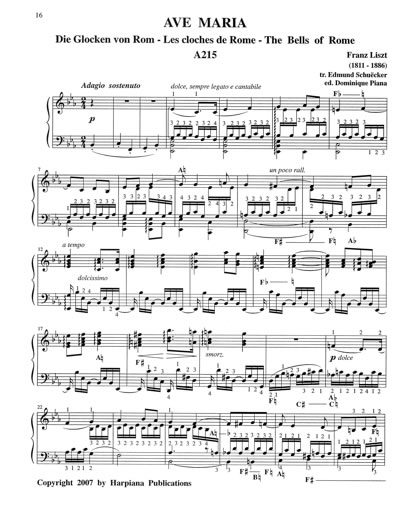| Editions
Harpiana Publications: Contemplation - The Franz Liszt Anthology for Harp
Ave Maria d’Arcadelt, arr. Liszt, tr. Peter Dubez (A 216)
|
| Editions Harpiana Publications - Index of Works |
Liszt and his Ave Maria settings
- Ave Maria d’Arcadelt,
arr. Liszt, tr. Peter Dubez (A 216)
- Ave Maria in Db Major, tr. Peter Dubez (A 247)
- Ave Maria in Eb Major (originally F major), tr. Edmund Schuëcker
Liszt and his Ave Maria settings
The three different Ave Maria compositions featured together in this volume are proving to be representative in many ways, as they reveal Liszt’s fervent longing for spiritual solace, his evolution as a composer on religious subjects and, more tenuously, yet evidenced by the very existence of these transcriptions, his undeniable connection to the harp. How else can one explain that harpists of his era chose these particular pieces to transcribe?
Each one of these works stands alone in the Liszt repertoire, yet they do not exhaust the genre. Another Ave Maria can be found in the Harmonies poétiques et religieuses originated in his earlier years or Ave Maria in G from his old age, both published in harp transcription in other volumes of this anthology.
Ave Maria d’Arcadelt turns out to be somewhat of a misnomer, because it was composed or shall we say - fabricated - by Louis Dietsch (1808-1865), a French composer based in Paris, renowned at the time for his sacred works, yet highly adept at attracting controversy. In 1842 he presented his “discovery” of a 4-voice Ave Maria by Arcadelt, but from the beginning, the faulty prosody of this work raised doubts as to its authorship. Later inquiries then revealed that Dietsch had indeed borrowed from Arcadelt, having adapted the 3-voice chanson Nous voyons que les hommes. Its catchy, almost conquering theme will assure the continued popularity of the tune.
Liszt composed his version for piano in 1862, which was published by Peters of Leipzig in 1865, then created another version for organ/harmonium (E 14).
Ave Maria in Db Major, subtitled aus den 9 Kirchechorgesängen, had originally been composed in D, either for harmonium (E 24), for mixed choir and organ (J 24) or for single voice and organ/harmonium (K 4). All these date from 1869 and were published between 1870 and 1882. Finally in 1873/74, Liszt composed his quite virtuosic piano version in Db, which immediately elicits the thought that he must have had the harp in mind all along.. .This very thought could be corroborated by a story Carl Lachmund, a pianist who attended Liszt’s Master Classes in the 1880’s and whose wife Caroline happened to be a harpist, tells in his Diary*.
In conversation with Caroline Lachmund, Liszt is eager to hear her play the harp and adds: “Well, I will send you my Ave Maria for harp - I have no copy here, but will order one from the publisher. The publisher was Herr Kahnt of Leipzig, also a regular visitor at Liszt gatherings, and mentioned elsewhere in the diary. Many weeks later this repeated promise was fulfilled.
Peter Dubez filled the position of harpist at the Court of Grand Duke Carl Alexander in Weimar some time after Liszt’s resignation as Kapellmeister there in 1859. Liszt never severed his ties to Weimar completely, embarking on an itinerant life-style that began with lengthy stays in Rome, where he developed a growing fascination for plainchant and Palestrina. Despite the lack of record, Dubez must have collaborated with Liszt on this project one way or another, given what we know about the genesis of the Angelus transcription by Wilhelm Posse in the 1880’s.
Ave Maria in Eb (A 215) was transcribed by Edmund Schuëcker (1860-1911), the Professor of Harp at the Royal Conservatory of Music at Leipzig and published (by Carl Merseburger) in Volume LV of his Etüden und Melodien-Album op.8, a collection of selected pieces, etudes in progressive order, original works as well as arrangements for pedagogic use. Liszt had composed it originally for piano in 1862, in his favored blissful key of E Major, for another undertaking of encyclopedic proportions: the Große Klavierschule von Lebert und Stark, published in Stuttgart by the Cotta’sche Buchhandlung in 1863 with the subtitle Die Glocken von Rom. Dr. Sigmund Lebert (1822-1884) and Dr. Ludwig Stark (1831-1884) had established the Stuttgart Conservatory, and Liszt also composed his concert studies Waldesrauschen and Gnornenreigen for them.
A 215, A 216 and A 247 represent the new classification of Liszt’s works in the New Grove Dictionary of Music and Musicians, 2nd edition.
Some light revisions were required, beyond the thorough editing already provided by the 19th century transcribers, to make this music entirely playable, especially in respect to pedaling in Schuëcker’s transcription, or to the texture of the Ave Maria d’Arcadelt, after careful comparison with Liszt’s original piano versions.
A copy of the Zwei Ave Maria (in this volume, the first two) was provided by Maria Eckhardt, the Director of the Liszt Museum in Budapest.
Françoise Bourret from Québec typeset the music on Finale.
Dominique Piana
*Chapter 16, p. 152, Living with Liszt, from The Diary of Carl Lachmund, An American Pupil of Liszt, 1882-1884, Revised Edition by Alan Walker, Pendragon Press, Stuyvesant, NY, 1998

| Title: | Two Ave Maria |
| Composer: | Arcadelt / Liszt / tr Dubez / |
| Arranger: | Edited Dominique Piana |
| Instrumentation: | Solo Harp |
| Level: | Advanced |
| Format: | Harp Score Stapled |
| Size: | 11" x 8.5" (US Letter) |
| ISMN: | Not issued |
| Our Ref: | DP042 |
| Publisher: | Editions Harpiana Publications |
| Series: | Contemplation - The Franz Listz Anthology for Harp |
| Edition/Year: | 2007 |
| Origin: | USA |
 Two
Ave Maria
Two
Ave Maria